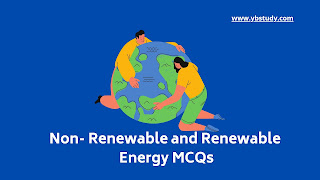MCQ on Renewable and Non-Renewable Energy Pdf
MCQ on Renewable and Non-Renewable Energy Pdf: Renewable energy can be continuously regenerated and replenished regularly in nature. Renewable energy can all be recycled and will not be reduced due to long-term use.
Renewable energy refers to non-fossil energy such as wind energy, solar energy, hydro energy, biomass energy, geothermal energy, ocean energy, etc. It is an inexhaustible and inexhaustible energy source.
It is a kind of non-renewable energy that is harmless to the environment or has very little harm, and the resources are widely distributed, so it is suitable for on-site development and utilization.
Non-renewable energy has been formed over hundreds of millions of years and cannot be recovered in a short period. Non-renewable energy sources: As they are exploited and utilized on a large scale, their reserves are getting smaller and smaller, and they will always be exhausted.
Non-renewable energy: refers to the energy resources that cannot be regenerated at the current stage after human development and utilization, called “non-renewable energy”. For example, coal and oil are the remains of ancient organisms that were buried deep underground and formed after a long period of evolution (so they are also called “fossil fuels”).
It can be regenerated within 10,000 years, so it belongs to “non-renewable energy”. In addition, non-renewable energy sources include coal, oil, natural gas, nuclear energy, and oil shale.
MCQ on Renewable and Non-Renewable Energy Pdf
1. Which one of the following energy uses windmills for mechanical power?
1. Solar energy
2. Biomass and biofuel
3. Hydropower
4. Wind power
Answer: 4. Wind power
2. A Solar cell is an electrical device that converts the energy of light directly into electricity by the ____________
1. Photovoltaic effect
2. Chemical effect
3. Atmospheric effect
4. Physical effect
Answer: 1. Photovoltaic effect
3. Photovoltaic cell converts solar energy into_______
1. heat energy
2. electric energy
3. mechanical energy
4. chemical energy
Answer: 2. electric energy
4. Which of the following are renewable energy resources?
1. Solar
2. Wave
3. Wind
4. All
Answer: 4. All
5. Which of the following is a disadvantage of renewable energy?
1. High pollution
2. Available only in a few places
3. High running cost
4. Unreliable supply
Answer: 4. Unreliable supply
6. What is the primary component of coal?
1. Nitrogen
2. Carbon
3. Oxygen
4. Hydrogen
Answer: 2. Carbon
7. In hydroelectric power, what is necessary for the production of power throughout the year?
1. Dams filled with water
2. High amount of air
3. High intense sunlight
4. Nuclear power
Answer: 1. Dams filled with water
8. The International Renewable Energy Agency (IRENA) was formed in________
1. 2008
2. 2009
3. 2010
4. 2011
Answer: 2. 2009
9._______is the first oil well drilled in Asia?
1. Karachi, Pakistan
2. Assam, India
3. Tokyo, Japan
4. Kandy, Sri Lanka
Answer: 2. Assam, India
10. Which of the following theory is related to non-renewable resources?
1. Game Theory
2. Phlogiston Theory
3. Big Bang Theory
4. Hotelling’s Theory
Answer: 4. Hotelling’s Theory
11. Which of the following are non-renewable energy resources?
1. Nuclear energy
2. Fossil fuels
3. Both a and b
4. None of the above
Answer: 3. Both a and b
12. How many Nuclear power stations are there in India?
1. 5
2. 6
3. 7
4. 8
Answer: 3. 7
13. _________ is the source of solar energy?
1. Wind
2. Waves
3. Sunlight
4. All of the above
Answer: 3. Sunlight
14. _____ of our energy use comes from fossil fuels.
1. 86%
2. 45%
3. 61%
4. 30%
Answer: 1. 86%
15. What is the source of wind energy?
1. Wind
2. Waves
3. Sunlight
4. None of the above
Answer: 1. Wind
16. Which of the following resources are recyclable?
1. Renewable resources
2. Non-renewable resources
3. Both a and b
4. None of the above
Answer: 1. Renewable resources

